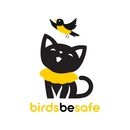Summary of Australian Science Study of Birdsbesafe Collar Covers
Birdsbesafe® cat collar covers were studied in scientific field studies at two universities, using owned pet cats, in Australia (report is here) and in New York state (U.S.) (report). We really very much appreciate that the scientific community has found out about our innovative product and sought it out for field-testing under scientific scrutiny. You can read the original reports, but for quicker reading, here is our summary of the Australian study, along with our comments.
From the Journal of Applied Animal Behavior and Murdoch University researchers:
- "Captures of birds and herpetofauna, but not mammals, fell when cats wore a [Birdsbesafe® cat collar cover.]"
- The rates of reduction in prey capture among prey with specialized color vision was 47% - 54% for the multi-year study.
- A large percentage of bird species captured when Australian cats wore the device were these birds: "honey-eaters", local doves, and pigeons. The Birdsbesafe collar covers may be less effective with these birds than with commonly preyed-upon bird species in North America and Europe. See more detail, below.
- "To date, the [Birdbesafe® device] is the only predation deterrent protecting herpetofauna."
- "Overall, 77% of owners planned to continue using the [Birdsbesafe® cover] after the study finished."
- 96% of the participants (who, in total, owned 114 pet cats) said that their cats either had no problems (79%) or adjusted within two days to wearing Birdsbesafe® covers.
- No reduction in mammal captures was noted, and in regions where there are rare, endangered or other mammals to preserve, Birdsbesafe may not be the best deterrent.
- The report includes a detailed discussion of birds' color vision ability, which is the basis for how Birdsbesafe® devices work.
Our Comments:
The biggest difference in the studies (between the U.S. and Australia) may be based on the fact that the housecats in the Perth region were not generally as active in hunting birds. Many of the study cats did not capture any birds. With low capture rates across the board, it is hard for the study to elucidate the true protective effect of the Birdsbesafe collar cover. Many of the comments in the study provide support for the effectiveness of Birdsbesafe covers, but unlike in the U.S. study, cats were not selected to be known bird-hunters in order to enter the study.
In our opinion, our customers who buy Birdsbesafe collar covers generally have cats that are actively catching birds--that's why they seek a solution that they buy from us. So, it seems to be fair to study cats that are most skilled at bird-catching, and we hope that future studies will be more able to do so.
Additionally, some birds in Australia my not see bright colors as well as the songbirds in our home region of North America. It could be the case that if your cat goes outdoors wearing bright colors, but its prey is not good at seeing bright colors, Birdsbesafe devices won't serve to protect the birds.
These species were preyed upon in the Perth area: honey-eaters, doves and pigeons. Doves and pigeons are not songbirds, so they may not see our products' colors as well as do songbirds (passerines). "Honey-eaters" may have different perceptions of certain colors or patterns that are not the same as other songbirds. They seek flowers.
What Can You Expect: If you're in New Zealand or Australia, your experience with Birdsbesafe cat collar covers will likely depend on just exactly which birds your cat may be able to hunt. We have customers give our products glowing reports of success, while others do not. There is something (roughly and non-scientifically) like 10% of the cat owners coming back to us with details of not seeing a good level of bird protection in their New Zealand or Australia environment. (In the U.S., the percentage of complaints of that kind, in contrast, is about .01%, in other words, negligible.)
We are trying to sort out details about colors, patterns and effectiveness, along with the geographic differences and more knowledge about species distribution. Admittedly, this is rather a big job, and it is rather beyond our scope at present, though we try. As of November 2015, an independent scientific field study is planned within New Zealand, and maybe that will be illuminating.
Our advice for New Zealanders and Australians as of November 2015: Keep your expectations more modest in your region than the 87% reduction shown by the U.S. study. You may get a 50% reduction in birds caught--or more--or less. Please discontinue use if there seems to be a poor result for your cat and your local birds. If there are problems, we'd like to hear about your location and experience. We will eventually be passing information on to conservation groups, science research professionals or other involved people.
Color Choices: Meanwhile, we are marketing the best assortment of colors and patterns, based on 6 years of customer feedback from your region, as well as scientific study. Our Birdsbesafe collar covers have the colors and patterns for the greatest chance of success, based on what we know now.
As always, thanks for caring about cats and birds.














